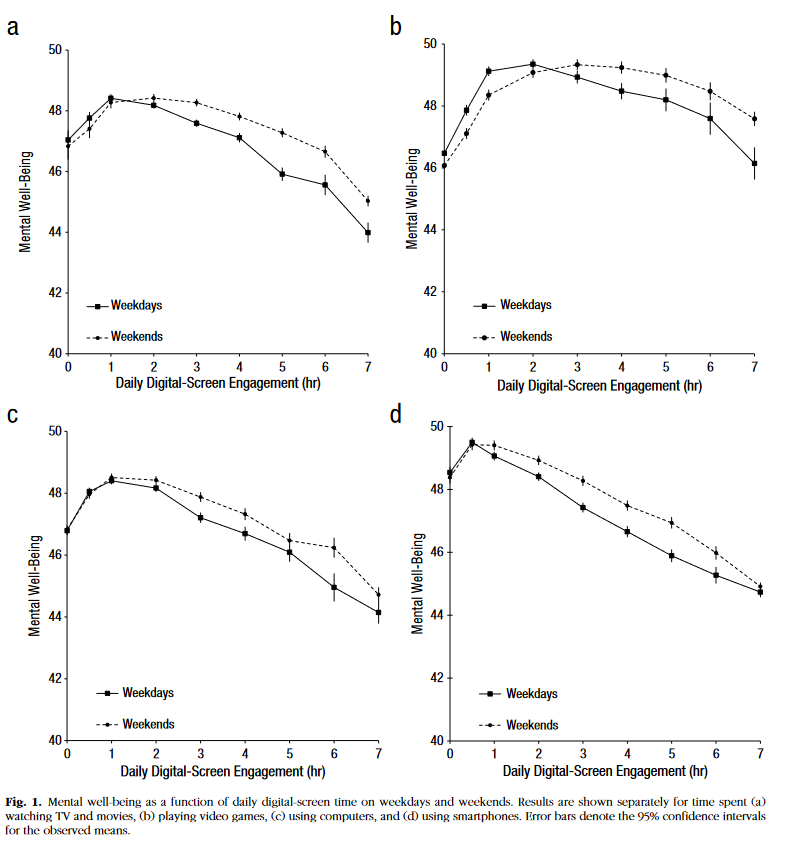In today's digital era, social media (SM) has become an integral aspect of adolescent life, providing avenues for socialization, connection, and self-expression. This ubiquitously calls for the understanding of the nuanced relationship between SM use and adolescent well-being. This article is the first of two regarding a study we conducted in collaboration with the University of Padova that aims to replicate the goldilocks hypothesis in Italian adolescents. This first part will introduce the theoretical rationale and explain the methodology behind the study, the second one will illustrate the results and discuss the findings.
The goldilocks hypothesis posits that digital media use at moderate levels is not intrinsically harmful and may be advantageous in an increasing technological world, whereas extreme use at both end of the spectrum may negatively affect psychosocial well-being (Przybylski & Weinstein, 2017). This theory underscores the importance of moderation in digital media consumption, highlighting the potential risks associated with both excessive use and complete avoidance of SM platforms. While moderate SM use may facilitate social connection and enhance communication skills, excessive use may lead to social isolation, decreased self-esteem, and psychological distress (Winstone et al., 2021). Conversely, complete avoidance of SM may result in missed opportunities for social interaction and community engagement, potentially hindering adolescents' social development and integration (Boniel-Nissim et al., 2022).
Research examining the goldilocks hypothesis has yielded mixed findings, with some studies supporting the theory while others finding no significant associations between SM use and well-being. For example, studies by Przybylski and colleagues (Przybylski et al., 2020; Przybylski & Weinstein, 2017) observed a concave-down quadratic relationship between SM use and well-being, with adolescents at the extremes of SM use reporting lower levels of well-being. (Figure. 1)

However, other studies utilizing longitudinal designs or ecological momentary assessment, which is a technique that involves multiple surveys over a short period of time, failed to replicate these findings (Boer et al.,2022; Jensen et al., 2019), indicating the need for further investigation.
Well-being is a multidimensional construct that can be influenced by SM use in several ways. Numerous studies have explored the impact of SM use on mental well-being, which is characterized by positive emotions, effective functioning, and a sense of life satisfaction (Seligman, 2011). Time spent on SM seems to be negatively related to mental well-being, with the use of these platform being associated to increases in social comparison, stress, worry and depressive symptoms. (Ivie et al.,2020). Nevertheless, SM can serve as compensatory instruments to cope with everyday difficulties, thus supporting those adolescents that need leisure or connection to escape negative feelings. In addition, multiple studies report that not all SM use has negative consequences. For instance, a study conducted with over 190,000 adolescents across 42 countries reported that those who use SM in an adaptive way reported higher life satisfaction compared to those who did not use it at all (Boniel-Nissim et al., 2022). Nevertheless, the same study showed that those who engaged in intensive use reported lower life satisfaction than their more balanced counterparts.
Social well-being, defined as the individuale valuation of one’s sense of belonginess and acceptance by their community (Keyes, 2002), is the second fundamental dimension of well-being. SM is a powerful tool in this regard. In fact, using these platforms young people can communicate and interact with others, enhancing their already existent social networks and creating new ones (Angelini et al.,2023). Furthermore, individuals that feel lonely may turn to SM to fulfill their belonging need sand temporarily relieve feelings of isolation. Numerous studies have expressed support for these hypotheses, with the cross-national study from above suggesting that individuals who engaged intensively with SM showed higher social support than those who used these platforms less consistently. Still, social support in this group was higher than in those who reported to use SM very little or not at all (Boniel-Nissim et al., 2022).
Age and gender are important moderators of theSM-well-being relationship, with younger adolescents and females often exhibiting greater vulnerability to the negative effects of SM use. Early adolescence is a period of heightened vulnerability to peer influence and social comparison, making younger adolescents more susceptible to the negative consequences of excessive SM use (Brinthaupt & Lipka, 2002). Gender differences in SM usage patterns also contribute to differential outcomes, with girls typically engaging more in social-oriented SM activities, such as sharing personal experiences and seeking social support, while boys may gravitate towards gaming and entertainment-focused platforms (Chang & Ko, 2023; Su et al., 2020). These gender differences may stem from societal expectations and norms surrounding gender roles, as well as differences in socialization experiences. These results suggest a plausible interaction between age and gender leading to worse well-being outcomes for early adolescent girls compared to boys, while at later ages these differences might be attenuated or non-existent.
With this rationale in mind, our study wanted to contribute to a deeper understanding of the goldilocks hypothesis and its applicability to adolescent well-being. Specifically, we investigated the quadratic association between SM use and both mental and social well-being in are presentative sample of Italian early adolescents, while examining the moderating effects of age and gender.
Data comprised 78,066 Italian adolescents (50.2% girls; mean age 14.1 years; SD = 2.2), gathered through the 2022 Italian Health Behaviour in School-aged Children (HBSC) study, a WHO Collaborative Cross-National Survey of school students (EpiCentro & Iss, 2024). Prior to data collection, students’ parents received an information note outlining the survey’s purpose. Families could decline participation by completing and returning the provided note to the teachers of the respective class. All measures were collected through self-report questions. Students compiled an online questionnaire which asked them information about their lifestyle, behaviors, and health. For this study, we gathered data on mental and social well-being, social media use and demographic information (such as gender, age, socioeconomic status, and family structure).
In part 2 we will explore our results, discuss them and provide some implications.